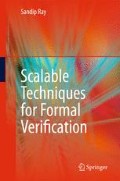Abstract
We consider the problem of formalizing a compositional model checking procedure with the ACL2 theorem prover. The algorithm uses conjunctive and cone of influence reductions to reduce a large model checking problem into a collection of smaller problems, and we prove the soundness of the composition of these reductions. The algorithm checks properties specified in Linear Temporal Logic (LTL), but the ACL2 logic does not allow us to express either the classical semantics of LTL or the classical soundness proofs for these reductions. We discuss ways of getting around this obstacle. We also discuss recent enhancements to ACL2, for example, a connection with the HOL4 theorem prover that may make similar efforts easier in future.
Access this chapter
Tax calculation will be finalised at checkout
Purchases are for personal use only
Notes
- 1.
Our formalization of LTL semantics is in terms of eventually periodic paths, and hence a path π here means a periodic path, but this characterization is preserved by our definition.
References
R. S. Boyer and J. S. Moore. Metafunctions: Proving them Correct and Using Them Efficiently as New Proof Procedure. In R. S. Boyer and J. S. Moore, editors, The Correctness Problem in Computer Science. Academic Press, London, UK, 1981.
C. Chou and D. Peled. Formal Verification of a Partial-Order Reduction Technique for Model Checking. Journal of Automated Reasoning, 23(3-4):265–298, 1999.
E. M. Clarke and E. A. Emerson. Design and Synthesis of Synchronization Skeletons Using Branching-Time Temporal Logic. In D. C. Kozen, editor, Logic of Programs, Workshop, volume 131 of LNCS, pages 52–71, Yorktown Heights, NY, May 1981. Springer-Verlag.
E. A. Emerson and V. Kahlon. Reducing Model Checking of the Many to the Few. In D. A. McAllester, editor, Proceedings of the 17th International Conference on Automated Deduction (CADE 2000), volume 1831 of LNCS, pages 236–254, Pittsburg, PA, July 2000. Springer-Verlag.
K. Gödel. Über formal unentscheidbare Sätze der Principia Mathematica und verwandter Systeme I. Monatshefte für Mathematic und Physik, 38:173–198, 1931.
K. Gödel. On Formally Undecidable Propositions of Principia Mathematica and Related Systems. Dover Publications, February 1992.
M. J. C. Gordon, W. A. Hunt, Jr., M. Kaufmann, and J. Reynolds. An Integration of HOL and ACL2. In A. Gupta and P. Manolios, editors, Proceedings on the 6th International Conference on Formal Methods in Computer-Aided Design (FMCAD-2006), pages 153–160, San Jose, CA, 2006. IEEE Computer Society Press.
M. J. C. Gordon and A. M. Pitts. The HOL Logic and System. In J. Bowen, editor, Towards Verified Systems, volume 2 of Real-Time Safety Critical Systems, chapter 3, pages 49–70. Elsevier Science B.V., 1994.
J. Harrison. Metatheory and Reflection in Theorem Proving: A Survey and Critique. Technical Report CRC-053, SRI International Cambridge Computer Science Research Center, 1995.
HOL 4, Kananaskis 1 release. http://hol.sf.net/.
M. Kaufmann and J. S. Moore. Structured Theory Development for a Mechanized Logic. Journal of Automated Reasoning, 26(2):161–203, 2001.
P. Manolios. Mu-Calculus Model Checking in ACL2. In M. Kaufmann, P. Manolios, and J. S. Moore, editors, Computer-Aided Reasoning: ACL2 Case Studies, pages 73–88. Kluwer Academic Publishers, Boston, MA, June 2000. (one more editor s present)
S. Ray, J. Matthews, and M. Tuttle. Certifying Compositional Model Checking Algorithms in ACL2. In W. A. Hunt, Jr., M. Kaufmann, and J. S. Moore, editors, 4th International Workshop on the ACL2 Theorem Prover and Its Applications (ACL2 2003), Boulder, CO, July 2003.
K. Schneider and D. W. Hoffmann. A HOL Conversion for Translating Linear Time Temporal Logic to ω-Automata. In Y. Bertot, G. Dowek, A. Hirschowitz, C. Paulin, and L. Théry, editors, Proceedings of the 12th International Conference on Theorem Proving in Higher Order Logics (TPHOLS 1999), volume 1690 of LNCS, pages 255–272, Nice, France, 1999. Springer-Verlag.
J. von Wright. Mechanizing the Temporal Logic of Actions in HOL. In M. Archer, J. J. Joyce, K. N. Levitt, and P. J. Windley, editors, Proceedings of the 4th International Workshop on the HOL Theorem Proving System and Its Applications, pages 155–161, Davis, CA, August 1991. IEEE Computer Society Press.
R. Weyhrauch. Prolegomena to a Theory of Mechanized Formal Reasoning. Artificial Intelligence Journal, 13(1):133–170, 1980.
Author information
Authors and Affiliations
Corresponding author
Rights and permissions
Copyright information
© 2010 Springer Science+Business Media, LLC
About this chapter
Cite this chapter
Ray, S. (2010). A Compositional Model Checking Procedure. In: Scalable Techniques for Formal Verification. Springer, Boston, MA. https://doi.org/10.1007/978-1-4419-5998-0_13
Download citation
DOI: https://doi.org/10.1007/978-1-4419-5998-0_13
Published:
Publisher Name: Springer, Boston, MA
Print ISBN: 978-1-4419-5997-3
Online ISBN: 978-1-4419-5998-0
eBook Packages: EngineeringEngineering (R0)

